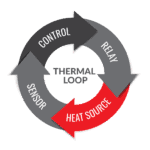*Note – This is the fifth article in our series on the thermal loop. See the bottom of this article for all posts in this series.
What is Proportional Control?
Proportional control, is when a temperature set point is dialed in and set. In a heating application, the temperature comes close to the set point as heat is applied. The controller begins to throttle the heating load off and on quickly if once it hits a deadband that is normally 3-5% before or after the set point. For example, if the set point to heat was 100 F, and the controller had a 5% deadband, there would be a range of 5% around the set point. 5% of 100 F is 5 F, and most proportional controllers will “split” the deadband around the set point: 2-3 degrees above, and 2-3 degrees below.
Once the sensed temperature reaches 95-97 F, the controller will actually proportion the power output signal to the relay, kind of “tapping the breaks” a bit, until it hits 100 F. The sensed temperature will overshoot the set point a little, maybe by just a couple of degrees. As power is removed from the circuit, temperature falls again. Once a temperature has reached 2-3% below the set point, the controller will begin to proportion the signal on again until it hits 100 F, then it is full on again.

Proportional controllers do a better job controlling the temperature around the setpoint than On/Off controllers or basic thermostat They provide for a more stable range of temperatures. This mode of temperature control also eliminates much of the hard on and off cycling of an on off control mode. Finally, proportional temperature control will also use power more efficiently, resulting in a cost savings over on/off control.
Many people will use a full PID temperature controller and just turn off the I&D. This allows the controller to not have to work as hard and perform as many calculations as related to integral and derivative functions.
If your application can withstand a couple of degree fluctuations around the set point, and you would like to have more accurate control that you get with an old fashioned thermostat, proportional control could be the answer you have been looking for.
The Thermal Loop Series
2- What is a Temperature Controller and How Does It Work?
4- On/Off Controls and the Thermal Loop
Powerblanket's industrial control solutions give you the power to automate, remotely control, and monitor your valuable materials and equipment.






